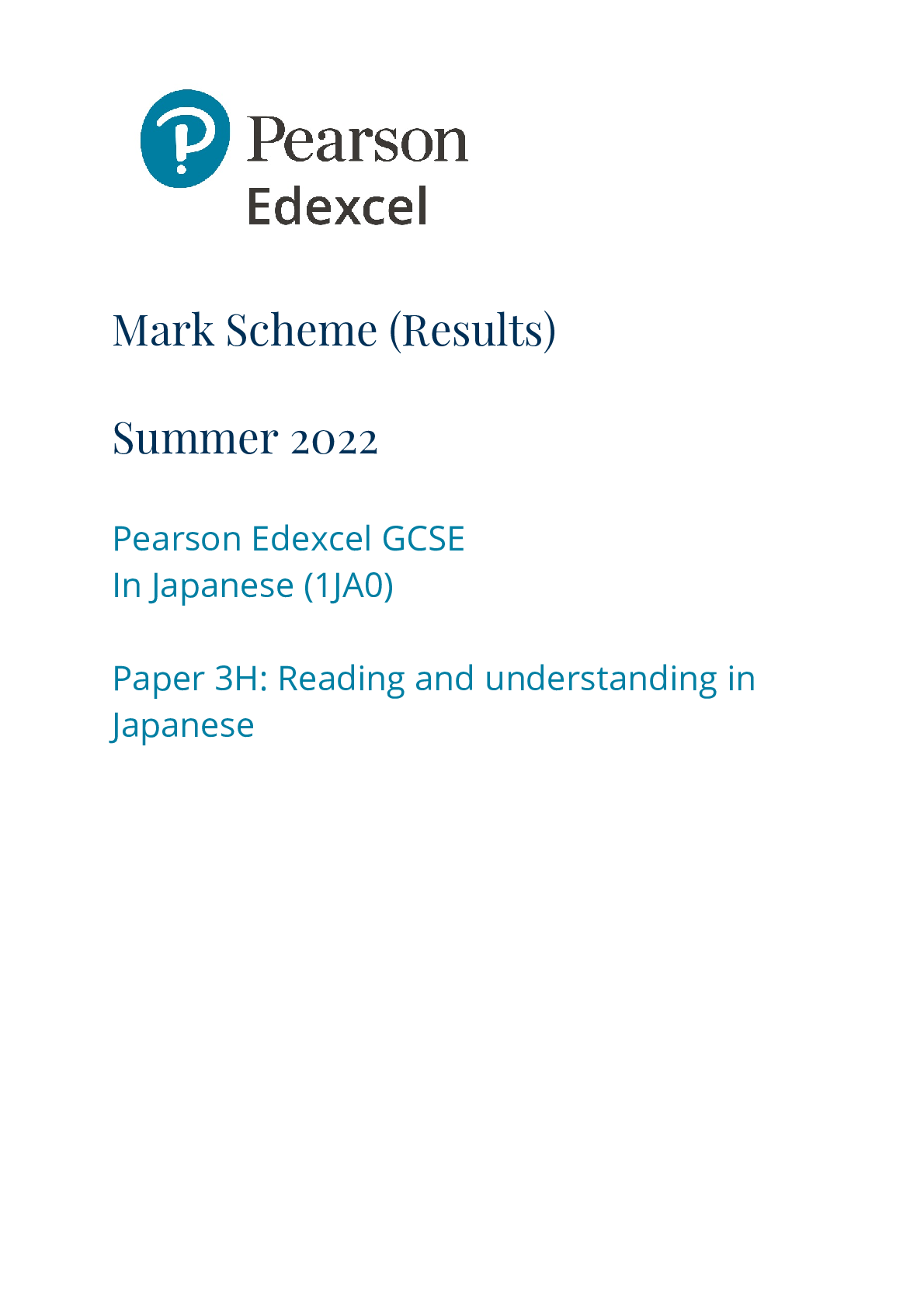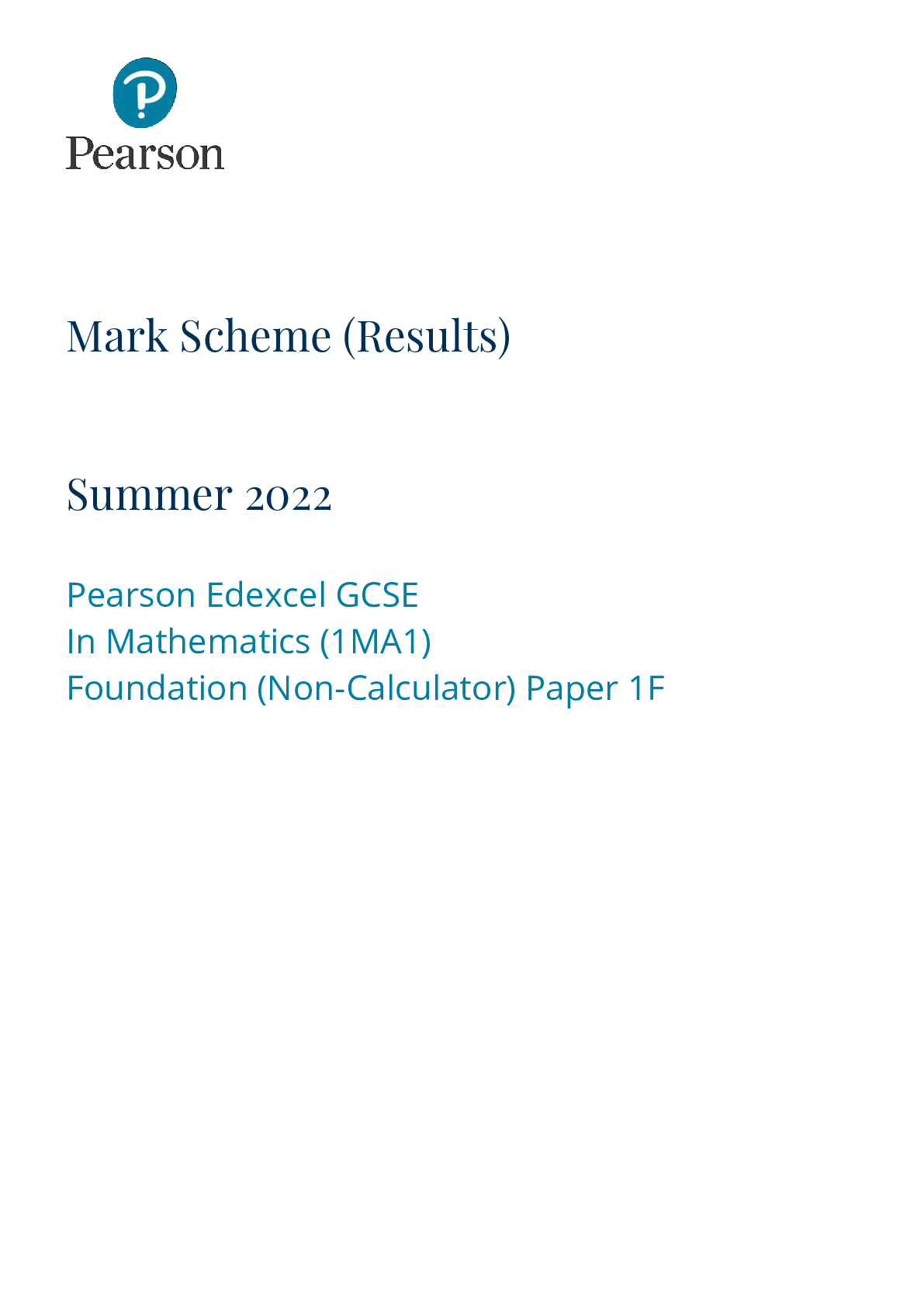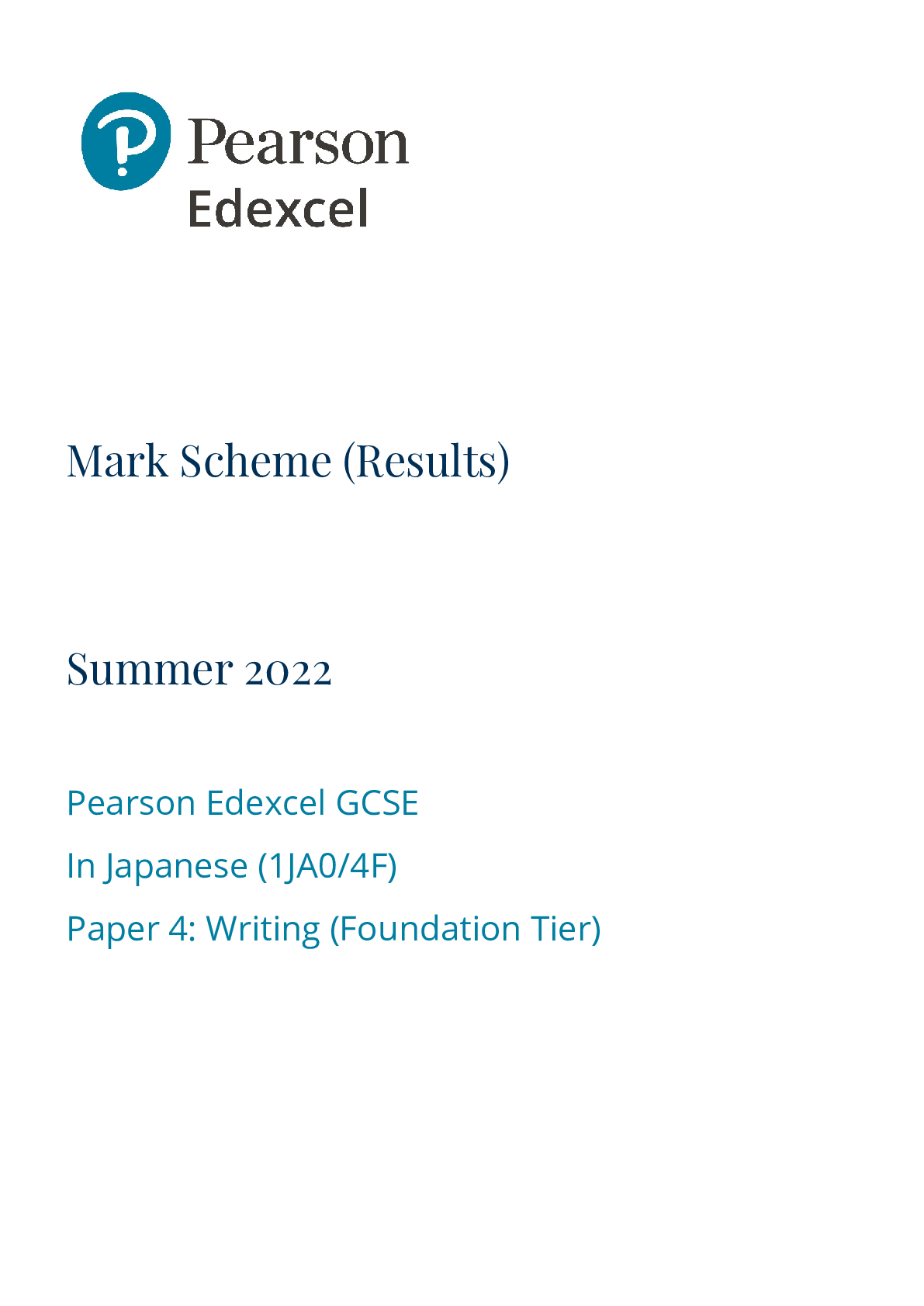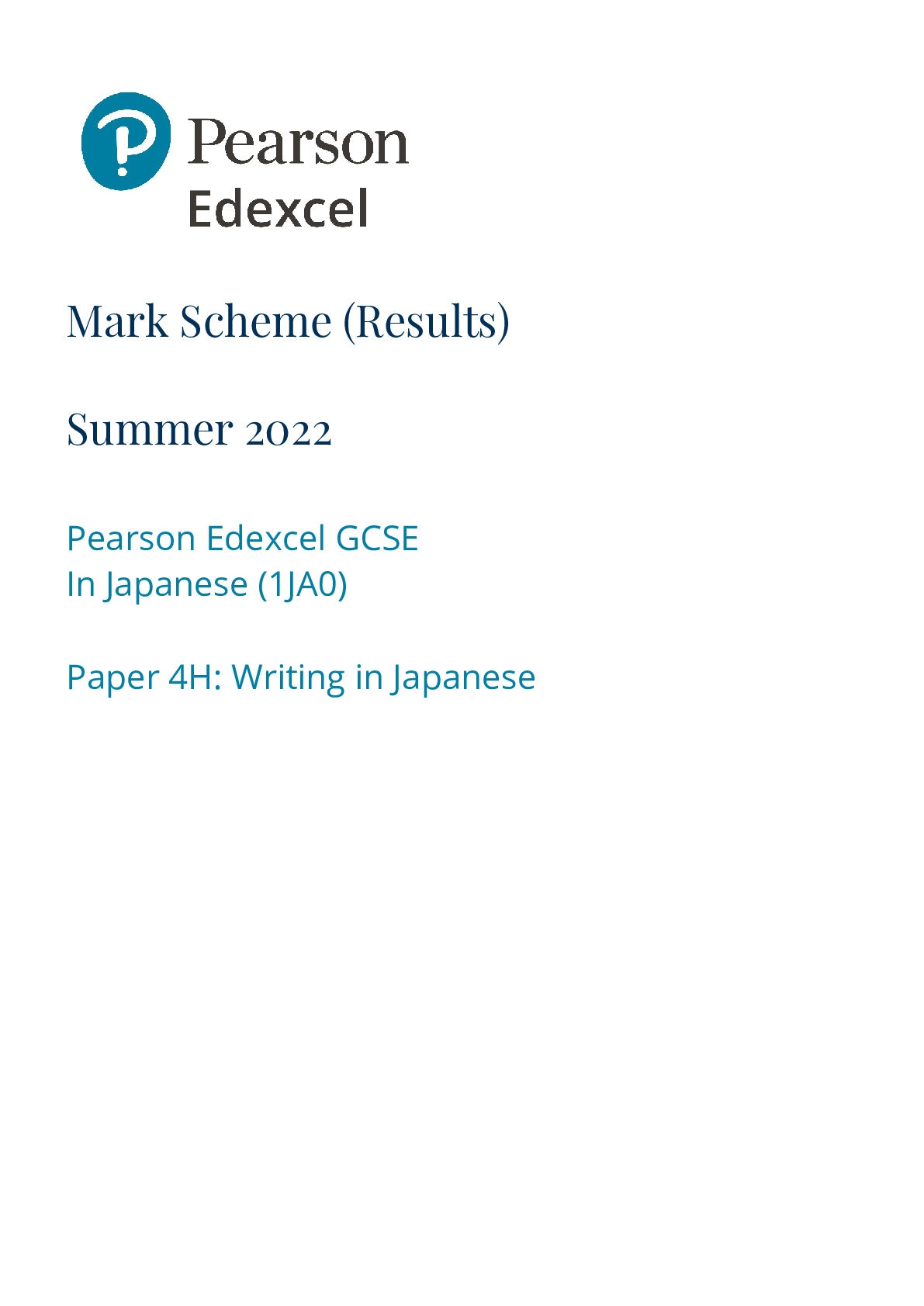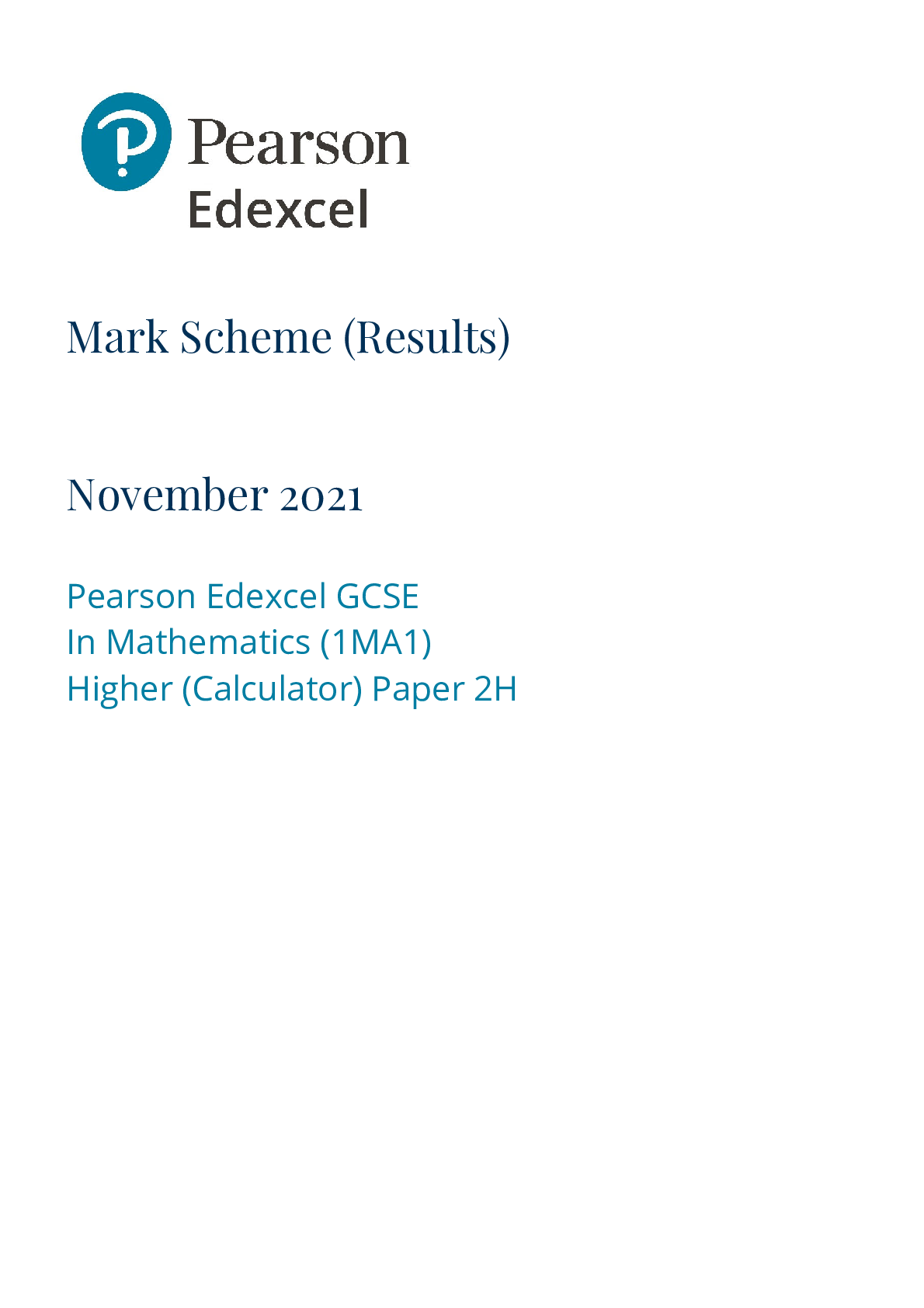Chemistry > MARK SCHEME > Mark Scheme (Results) Summer 2022 Pearson Edexcel GCSE In Chemistry (1CH0) Paper 1H Edexcel and BTEC (All)
Mark Scheme (Results) Summer 2022 Pearson Edexcel GCSE In Chemistry (1CH0) Paper 1H Edexcel and BTEC Qualifications
Document Content and Description Below
Mark Scheme (Results) Summer 2022 Pearson Edexcel GCSE In Chemistry (1CH0) Paper 1H Edexcel and BTEC Qualifications Edexcel and BTEC qualifications are awarded by Pearson, the UK’s largest awa... rding body. We provide a wide range of qualifications including academic, vocational, occupational and specific programmes for employers. For further information visit our qualifications websites at www.edexcel.com or www.btec.co.uk. Alternatively, you can get in touch with us using the details on our contact us page at www.edexcel.com/contactus. Pearson: helping people progress, everywhere Pearson aspires to be the world’s leading learning company. Our aim is to help everyone progress in their lives through education. We believe in every kind of learning, for all kinds of people, wherever they are in the world. We’ve been involved in education for over 150 years, and by working across 70 countries, in 100 languages, we have built an international reputation for our commitment to high standards and raising achievement through innovation in education. Find out more about how we can help you and your students at: www.pearson.com/uk November 2022 Publications Code 1CH0_1H_2206_MS All the material in this publication is copyright © Pearson Education Ltd 2022 General Marking Guidance • All candidates must receive the same treatment. Examiners must mark the first candidate in exactly the same way as they mark the last. • Mark schemes should be applied positively. Candidates must be rewarded for what they have shown they can do rather than penalised for omissions. • Examiners should mark according to the mark scheme not according to their perception of where the grade boundaries may lie. • There is no ceiling on achievement. All marks on the mark scheme should be used appropriately. • All the marks on the mark scheme are designed to be awarded. Examiners should always award full marks if deserved, i.e. if the answer matches the mark scheme. Examiners should also be prepared to award zero marks if the candidate’s response is not worthy of credit according to the mark scheme. • Where some judgement is required, mark schemes will provide the principles by which marks will be awarded and exemplification may be limited. • When examiners are in doubt regarding the application of the mark scheme to a candidate’s response, the team leader must be consulted. • Crossed out work should be marked UNLESS the candidate has replaced it with an alternative response. Mark schemes have been developed so that the rubrics of each mark scheme reflects the characteristics of the skills within the AO being targeted and the requirements of the command word. So for example the command word ‘Explain’ requires an identification of a point and then reasoning/justification of the point. Explain questions can be asked across all AOs. The distinction comes whether the identification is via a judgment made to reach a conclusion, or, making a point through application of knowledge to reason/justify the point made through application of understanding. It is the combination and linkage of the marking points that is needed to gain full marks. When marking questions with a ‘describe’ or ‘explain’ command word, the detailed marking guidance below should be consulted to ensure consistency of marking. Assessment Objective Command Word Strand Element Describe Explain AO1* An answer that combines the marking points to provide a logical description An explanation that links identification of a point with reasoning/justification(s) as required AO2 An answer that combines the marking points to provide a logical description, showing application of knowledge and understanding An explanation that links identification of a point (by applying knowledge) with reasoning/justification (application of understanding) AO3 1a and 1b An answer that combines points of interpretation/evaluation to provide a logical description AO3 2a and 2b An explanation that combines identification via a judgment to reach a conclusion via justification/reasoning AO3 3a An answer that combines the marking points to provide a logical description of the plan/method/experiment AO3 3b An explanation that combines identifying an improvement of the experimental procedure with a linked justification/reasoning *there will be situations where an AO1 question will include elements of recall of knowledge directly from the specification (up to a maximum of 15%). These will be identified by an asterisk in the mark scheme. Paper 1CH0_1H Higher Tier Question number Answer Additional Guidance Mark 1(a) A description to include any two in the correct sequence from • starts bright (1) • becomes dimmer (1) • goes out (over time) (1) Ignore gets brighter allow bulb stops working (2) AO1-1 Question number Answer Mark 1(b) B copper has a high melting point is the only correct answer A, C and D are incorrect as they are not typical properties of transition metals (1) AO1-1 Question number Answer Mark 1(c) C 2.56 x 10-10 is the only correct answer A, B and D are mathematically incorrect (1) AO2-1 Question number Answer Additional Guidance Mark 1(d) Diagram showing • arrangement of labelled copper and zinc atoms to show disruption (1) • copper : zinc in (approximate) ratio 7 : 3 (1) minimum 2 layers for mark allow lack of labelling if clear distinction between Zn & Cu (eg shading) (2) AO1-1 Total for Question 01 = 6 marks Question number Answer Mark 2(a) A solid aqueous aqueous liquid is the only correct answer B is incorrect because hydrochloric acid is aqueous C and D are incorrect as barium hydroxide is a solid (1) AO1-1 Question number Answer Additional guidance Mark 2(b)(i) burette / (volumetric/graduated) pipette allow syringe ignore any form of measuring cylinder / volumetric flask / dropping pipette (1) AO3-3b Question number Answer Additional guidance Mark 2(b)(ii) A description to include • (observe / look at) colour produced on (universal indicator) paper (1) • compare to pH {chart / scale} (1) allow (paper/solution/mixture) changes colour / specific colours given of UI ignore incorrect linking colour to acidity ignore reference to other indicators ignore reference to pH meters (2) AO2-2 Question number Answer Additional guidance Mark 2(b)(iii) An explanation linking • litmus paper only shows if the solution is {acidic / alkaline} (1) • does not show how acidic or alkaline the solution is (1) allow litmus goes red in acid, blue in alkali / litmus only has 2 colours / only UI gives a wide range of colours / litmus paper does not have a gradual change in colour ignore references to purple and neutral ignore litmus is not {precise / accurate} allow does not give the pH / litmus does not give accurate pH allow litmus paper does not show a gradual change in pH / ORA allow litmus does not give ‘strength’ of acid/alkali allow litmus paper is qualitative not quantitative (1) reject answers referring to use in test for chlorine (2) AO3- 2a 2b Question number Answer Additional Guidance Mark 2(b)(iv) • linear scales on both axes (1) • {plotted points / best fit line} must cover at least half graph paper in both directions (1) • 7 or more points plotted correctly ( half a square) (1) axes must be numbered (pH can start at 1) allow MP2 and MP3 if axes reversed must have numbered scale to score MP3 allow MP1 only for bar chart / histogram reject plotting on scale that uses the values from the table on Y axis (1, 1, 1, 1, 2, 7, 12, 13, 13) (3) AO2-1 Total for Question 02 = 9 marks Question number Answer Mark 3(a)(i) B 2.8 is the only correct answer A is incorrect as there are too few electrons C and D are incorrect as there are too many electrons (1) AO1-1 Question number Answer Additional guidance Mark 3(a)(ii) An explanation linking • ions (in magnesium carbonate) {cannot move / in a fixed position / held in a lattice / held together by strong electrostatic forces} (1) • magnesium contains {delocalised/free} electrons (1) • electrons (in magnesium) can {flow / move} / are mobile (1) ignore charged particles throughout allow magnesium carbonate does not have {delocalised / free} electrons reject references to covalent bonding in magnesium carbonate for MP1 allow sea of electrons ignore ions in magnesium ignore carry a {charge / current} (3) AO2-1 Question number Answer Additional guidance Mark 3(b) MP1 – relative formula mass MgCO3 24.0 + 12.0 + 3x16.0 (1) (= 84.0) MP2 – division 24(.0) (1) (= 0.28571429) 84(.0) MP3 – conversion to percentage (0.28571429) x 100 (= 28.57 / 28.6 / 29) (1) 28.57 / 28.6 / 29 with or without working gains 3 marks. allow ECF for MP2 and MP3 must have 2 or more sig figs for MP2 e.g Mr = 52 (0) 24= 0.4615 (1) 52 x 100 = 46.2 (1) MP3 - x 100 mark only if using all 3 pieces of data in calculation allow any number of sig figs except 1 correctly rounded allow 84(.0) x 100 = 350 (2 [Show More]
Last updated: 1 year ago
Preview 1 out of 29 pages
Instant download

Instant download
Reviews( 0 )
Document information
Connected school, study & course
About the document
Uploaded On
Apr 03, 2023
Number of pages
29
Written in
Additional information
This document has been written for:
Uploaded
Apr 03, 2023
Downloads
0
Views
85



